
‘Impaired cerebrovascular responses to memory tasks in individuals with spinal cord injury (SCI) can be improved by aerobic exercise training. The decline in the perfusion demand is primarily due to physical deconditioning rather than injury itself.
’
Tweet it Now
One of the probable paths includes impaired neurovascular coupling –ability of cerebral vasculature to alter regional blood flow to sustain neural metabolism /activity. Neurovascular coupling in SCI:
To address the mechanism in the spinal cord injury, the research team analyzed the effect of injury and 6-month full-body aerobic exercise training on the cerebral blood flow response to cognitive demand (i.e., neurovascular coupling) in 24 individuals with SCI and 16 controls.
Cognitive demand was introduced in a graded fashion using a working memory task. Individuals with SCI (especially higher level injuries >T4) showed a longer reaction time most likely due to upper motor impairments.
T4 is the thoracic level of spinal cord that predominantly supplies nerves to upper part of the body. Individuals with low-level injuries (below T4) had higher aerobic capacity than high-level injuries and with training, the capacity increased in both groups.
Advertisement
Thus the study states that “the cognitive impairment after SCI reflects a decline in neurovascular coupling primarily due to physical deconditioning rather than injury itself. The latter can be mitigated by aerobic exercise training”.
Advertisement















